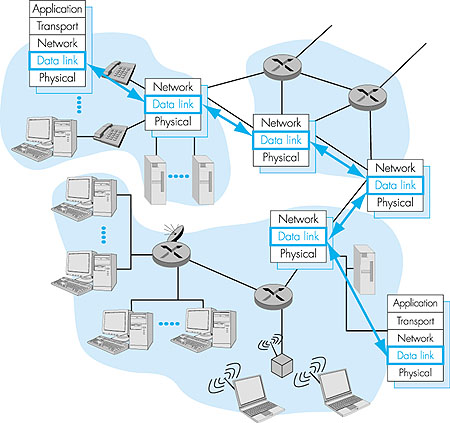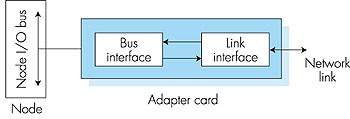5.1: The Data Link Layer: Introduction, Services
| In the previous
chapter we learned that the network layer provides a communication service
between two hosts. As shown in Figure 5.1, this communication path starts
at the source host, passes through a series of routers, and ends at the
destination host. We'll find it convenient here to refer to the hosts and
the routers simply as nodes (since, as we'll see shortly, we will
not be particularly concerned whether a node is a router or a host), and
to the communication channels that connect adjacent nodes along the communication
path as links. In order to move a datagram from source host to destination
host, the datagram must be moved over each of the individual links
in the path. In this chapter, we focus on the data-link layer, which
is responsible for transferring a datagram across an individual link. We'll
first identify and study the services provided by the link layer. In Sections
5.2 through 5.4, we'll then examine important principles behind the protocols
that provide these services (including the topics of error detection and
correction, so-called multiple access protocols that are used share a single
physical link among multiple nodes, and link-level addressing). We'll see
that many different types of link-level technology can be used to connect
two nodes. In Sections 5.5 through 5.10, we'll examine specific link-level
architectures and protocols in more detail.
5.1.1: The Services Provided by the Link LayerA link-layer protocol is used to move a datagram over an individual link. The link-layer protocol defines the format of the units of data exchanged between the nodes at the ends of the link, as well as the actions taken by these nodes when sending and receiving these data units. Recall from Chapter 1 that the units of data exchanged by a link-layer protocol are called frames, and that each link-layer frame typically encapsulates one network-layer datagram. As we shall see shortly, the actions taken by a link-layer protocol when sending and receiving frames include error detection, retransmission, flow control, and random access. Examples of link-layer protocols include Ethernet, token ring, FDDI, and PPP; in many contexts, ATM and frame relay can be considered link-layer protocols as well. We'll cover these protocols in detail in the latter half of this chapter.Whereas the network layer has the end-to-end job of moving transport-layer segments from the source host to the destination host, a link-layer protocol has the node-to-node job of moving a network-layer datagram over a single link in the path. An important characteristic of the link layer is that a datagram may be handled by different link-layer protocols on the different links in the path. For example, a datagram may be handled by Ethernet on the first link, PPP on the last link, and frame relay on all intermediate links. It is important to note that the services provided by the different link-layer protocols may be different. For example, a link-layer protocol may or may not provide reliable delivery. Thus, the network layer must be able to accomplish its end-to-end job in the face of a varying set of individual link-layer services. In order to gain insight to the link layer and how it relates to the network layer, let's consider a transportation analogy. Consider a travel agent who is planning a trip for a tourist traveling from Princeton, New Jersey, to Lausanne, Switzerland. Suppose the travel agent decides that it is most convenient for the tourist to take a limousine from Princeton to JFK airport, then a plane from JFK airport to Geneva airport, and finally a train from Geneva's airport to Lausanne's train station. Once the travel agent makes the three reservations, it is the responsibility of the Princeton limousine company to get the tourist from Princeton to JFK; it is the responsibility of the airline company to get the tourist from JFK to Geneva; and it is the responsibility of the Swiss train service to get the tourist from Geneva to Lausanne. Each of the three segments of the trip is "direct" between two "adjacent" locations. Note that the three transportation segments are managed by different companies and use entirely different transportation modes (limousine, plane, and train). Although the transportation modes are different, they each provide the basic service of moving passengers from one location to an adjacent location. In this transportation analogy, the tourist is analogous to a datagram, each transportation segment is analogous to a communication link, the transportation mode is analogous to the link-layer protocol, and the travel agent who plans the trip is analogous to a routing protocol. Although the basic service of any link layer is to "move" a datagram from one node to an adjacent node over a single communication link, the details of service will depend on the specific link-layer protocol that is employed over the link. Possible services that can be offered by a link-layer protocol include:
5.1.2: Adapters CommunicatingFor a given communication link, the link-layer protocol is, for the most part, implemented in an adapter. An adapter is a board (or a PCMCIA card) that typically contains RAM, DSP chips, a host bus interface, and a link interface. Adapters are also commonly known as network interface cards or NICs. As shown in Figure 5.2, the network layer in the transmitting node (that is, a host or router) passes a network-layer datagram to the adapter that handles the sending side of the communication link. The adapter encapsulates the datagram in a frame and then transmits the frame into the communication link. At the other side, the receiving adapter receives the entire frame, extracts the network-layer datagram, and passes it to the network layer. If the link-layer protocol provides error detection, then it is the sending adapter that sets the error detection bits and it is the receiving adapter that performs error checking. If the link-layer protocol provides reliable delivery, then the mechanisms for reliable delivery (for example, sequence numbers, timers, and acknowledgments) are entirely implemented in the adapters. If the link-layer protocol provides random access (see Section 5.3), then the random access protocol is entirely implemented in the adapters.
An adapter is a semi-autonomous unit. For example, an adapter can receive a frame, determine if a frame is in error and discard the frame without notifying its "parent" node. An adapter that receives a frame only interrupts its parent node when it wants to pass a network-layer datagram up the protocol stack. Similarly, when a node passes a datagram down the protocol stack to an adapter, the node fully delegates to the adapter the task of transmitting the datagram across that link. On the other hand, an adapter is not a completely autonomous unit. Although we have shown the adapter as a separate "box" in Figure 5.3, the adapter is typically housed in the same physical box as the rest of the node, shares power and busses with the rest of the node, and is ultimately under the control of the node.
As shown in Figure 5.3, the main components of an adapter are the bus interface and the link interface. The bus interface is responsible for communicating with the adapter's parent node. It transfers data and control information between the node and the NIC. The link interface is responsible for implementing the link-layer protocol. In addition to framing and de-framing datagrams, it may provide error detection, random access, and other link-layer functions. It also includes the transmit and receive circuitry. For popular link-layer technologies, such as Ethernet, the link interface is implemented by chip set that can be bought on the commodity market. For this reason, Ethernet adapters are incredibly cheap--often less than $30 for 10 Mbps and 100 Mbps transmission rates. Adapter design has become very sophisticated over the years. One of the critical issues in adapter performance has always been whether the adapter can move data in and out of a node at the full line speed, that is, at the transmission rate of the link. You can learn more about adapter architecture for 10 Mbps Ethernet, 100 Mbps Ethernet, and 155 Mbps ATM by visiting the 3Com adapter page [3Com 1999]. Data Communications magazine provides a nice introduction to Gbps Ethernet adapters [GigaAdapter 2000]. |


